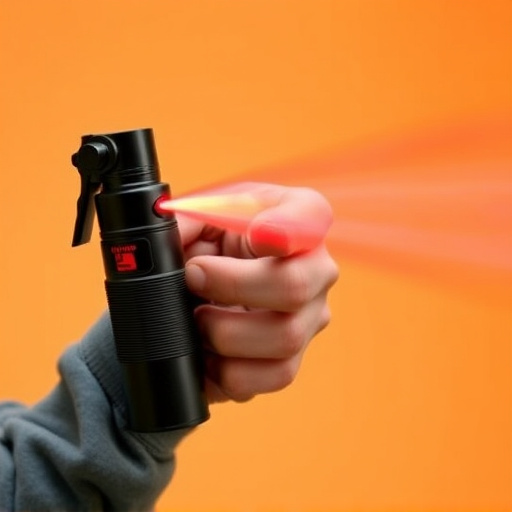Bear spray is a vital tool in outdoor first aid, offering temporary blindness and pain to escape aggressive animal encounters. Effective use requires understanding its range, following instructions, and knowing deactivation. Regular training with First Aid Supplies for Pepper Spray, including gauze pads, bandages, PPE, eye wash, wet wipes, antihistamines, pain relievers, and a flashlight, is crucial. Keep these supplies accessible, practice application techniques, target the animal's face, maintain spacing, and create a barrier. After exposure, immediate medical attention is vital; flush eyes and skin, use available first aid supplies for treatment, and follow up with healthcare professionals to monitor complications.
“Staying safe in wildlife encounters is paramount, especially when facing potential bear attacks. This article equips you with essential knowledge on how to defend against these powerful animals using bear spray—a powerful tool in your survival kit. We’ll explore ‘Understanding Bear Spray’ and its effectiveness as a deterrent. Additionally, we delve into crucial ‘First Aid Supplies for Pepper Spray’, providing guidance on what to have ready. Learn proven ‘Application Techniques’ to ensure maximum efficacy and discover the importance of ‘Post-Exposure Care’ to manage aftereffects. Be prepared, stay safe.”
- Understanding Bear Spray: An Effective Weapon Against Attacks
- What Are the First Aid Supplies Needed for Pepper Spray?
- Application Techniques: Maximizing Pepper Spray's Efficacy
- Post-Exposure Care: Treating and Preventing Aftereffects
Understanding Bear Spray: An Effective Weapon Against Attacks
Bear spray, also known as pepper spray, is a powerful and effective self-defense tool designed to deter aggressive animals like bears. It works by causing temporary blindness, pain, and irritation in the eyes and respiratory system of the target animal. This brief incapacitation allows the user time to escape or seek help. Understanding how bear spray works and knowing when to use it can significantly increase your survival chances during encounters with these formidable creatures.
When preparing for outdoor activities in bear country, incorporating first aid supplies that include pepper spray is a strategic move. Bear spray should be easily accessible and used as a last resort when an attack seems inevitable. It’s crucial to familiarize yourself with the spray’s range, usage instructions, and deactivation procedures. Regular training sessions can help ensure you’re ready if a bear encounter occurs, enabling you to respond quickly and effectively using these vital first aid supplies for pepper spray.
What Are the First Aid Supplies Needed for Pepper Spray?
When it comes to carrying bear spray as a defense mechanism against animal attacks, having the right first aid supplies is paramount. Beyond the obvious pepper spray can, a well-prepared individual should also possess a few key First Aid Supplies for Pepper Spray. These include sterile gauze pads and bandages for treating any cuts or abrasions that may occur during an encounter, especially if the spray makes contact with sensitive areas like eyes or mouth. Having a personal protective equipment (PPE) kit, such as gloves, is crucial to prevent direct contact with the spray.
Additionally, it’s beneficial to carry eye wash solutions and wet wipes to help flush out any pepper spray residue from the eyes and face. Antihistamines can be useful for mitigating skin irritation and swelling, while a small first aid kit should include pain relievers and anti-inflammatory drugs. Lastly, don’t forget to pack a whistle for drawing attention in case of an emergency and a flash light to navigate through low-visibility conditions.
Application Techniques: Maximizing Pepper Spray's Efficacy
When using bear spray as a defense mechanism, understanding application techniques is key to maximizing its efficacy. The first step involves ensuring your first aid supplies for pepper spray are readily accessible and easily deployable. This includes practicing the spray’s range, wind dynamics, and proper holding techniques. Aim for the face and eyes of the attacking animal, as these areas are most sensitive to the irritants in bear spray.
Proper spacing and angle are critical; you want to create a barrier between yourself and the threat without risking direct contact. Remember, bear spray is designed to temporarily disable and deter an attacker, giving you precious time to retreat or fight back. Regular training and familiarity with your gear will help ensure effective deployment during high-stress situations.
Post-Exposure Care: Treating and Preventing Aftereffects
After an animal attack, proper post-exposure care is essential, especially if bear spray was used as a defense. The first step is to seek medical attention immediately, even if the injuries seem minor. Bear spray can cause various physical reactions, including eye irritation, difficulty breathing, and skin burns, so professional evaluation is crucial. First Aid Supplies for Pepper Spray should be readily available, including clean bandages, antiseptics, and pain relievers.
To prevent long-term issues, thorough cleaning of the affected areas is vital. This involves flushing eyes with water for at least 15 minutes and thoroughly washing any sprayed skin. Medical professionals may also recommend antihistamines or corticosteroids to reduce inflammation and discomfort. Additionally, keeping a close eye on potential signs of infection, such as redness, swelling, or pus, is essential. Regular follow-up appointments can ensure that any aftereffects are addressed promptly, promoting faster healing and reducing the risk of complications.
Bear spray, as a vital tool in defending against animal attacks, requires proper understanding and usage. By equipping yourself with the right first aid supplies for pepper spray, such as eye wash and neutralizing agents, you can enhance its effectiveness. Mastering application techniques ensures optimal coverage and maximum impact. Post-exposure care is crucial to managing aftereffects and preventing complications, ensuring your safety and well-being in the event of a bear encounter.
